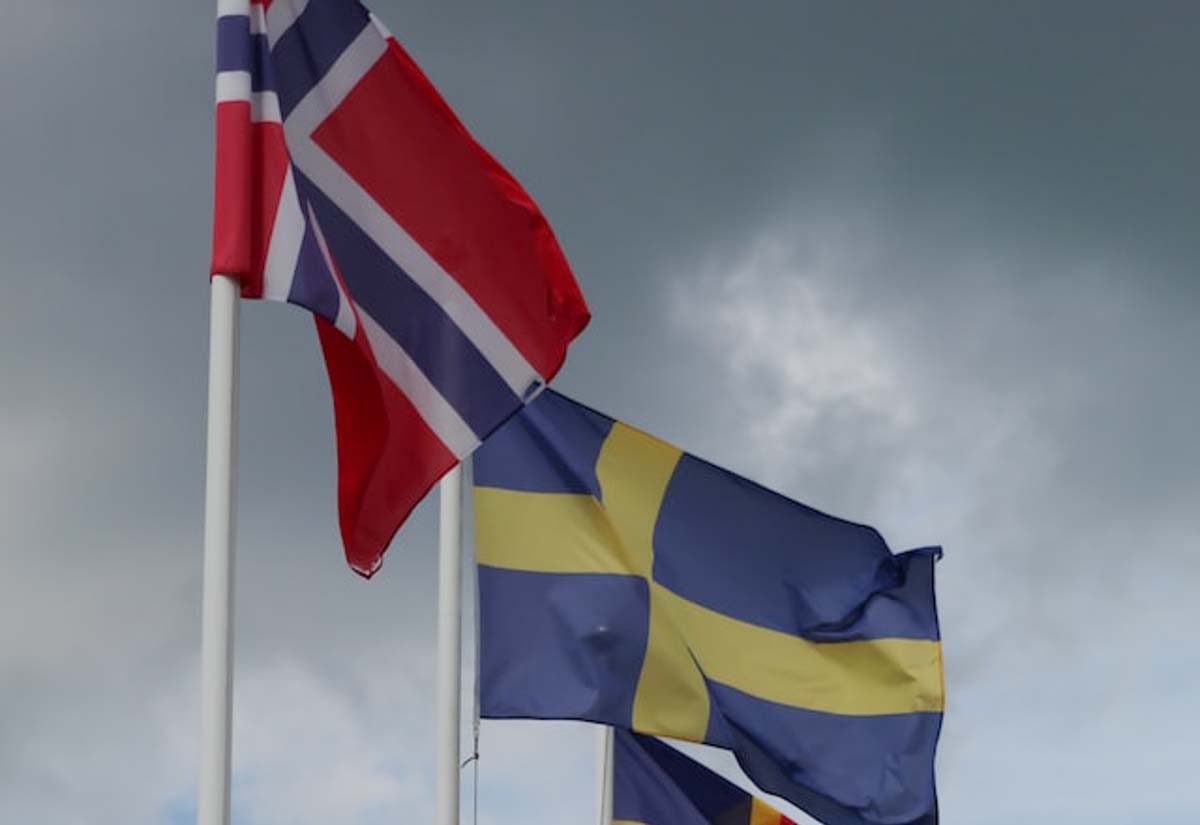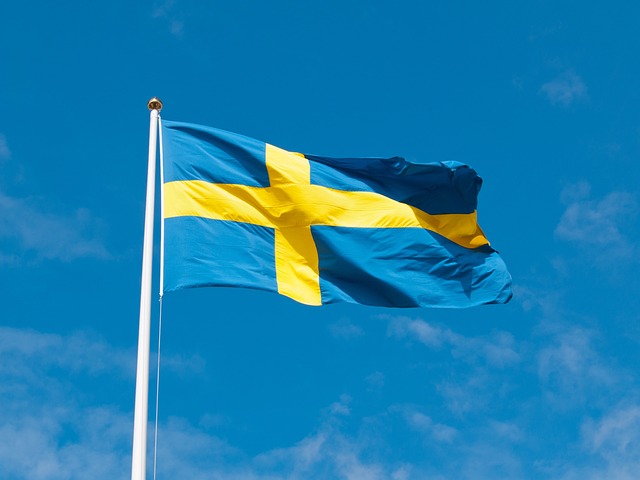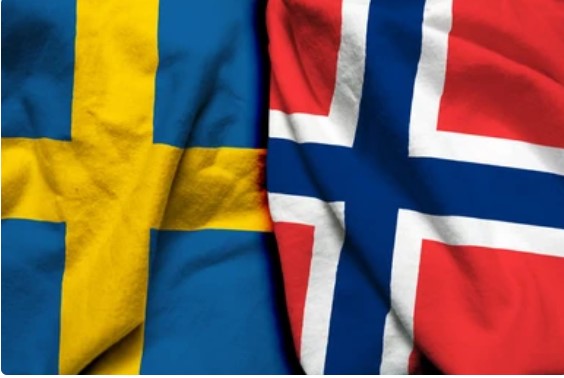
Does Norway And Sweden Speak The Same Language?
Norwegians and Swedes share a friendly rivalry, taking pride in their own language and cultural identity. Even so, there are more similarities than they would like to admit. This is perhaps most evident in the language, and poses the question; Does Norway and Sweden speak the same language?

Key takeaways
- Norway and Sweden have to distinct languages
- Norwegians speak Norwegian
- Swedes speak Swedish
- They are very similar
- They can communicate easily
- More similarities than differences
- Historical ties cause the similarities
- Norwegian is easiest to learn
- Norwegians can communicate with Swedes and Danes, they cannot communicate with each other.
Do Norway And Sweden Speak The Same Language?
Hidden away in their northern corner of the world, many people don’t know much about the Nordic languages spoken in Scandinavia. In fact, it’s common to presume that Norwegians, and Swedes all speak the same language. But this is not the case.
Norwegians speak Norwegian and Swedes speak Swedish. These are two distinct languages, but they are closely related. They both belong to the same branch of the Germanic language tree, North Germanic. They both have their roots in the language spoken by their viking ancestors, Old Norse, and they both are similar enough to where Swedes and Norwegians can converse with each other in their own languages relatively problem free.
In terms of the language, they share many of the same common denominators. The syntax, grammar and vocabulary are all closely related. So related in fact, that learning one of these languages allows you to communicate with ease with speakers of the other language.
However, don’t let that fool you. There are several differences between the languages that can cause some headaches and confusion. There are plenty of false friends, or words that sound the same in both languages but mean different things. Pronunciation also differs widely between the two, and given the vast array of different dialects in both countries, with Norway having the largest gap between dialects, it can become confusing for some Norwegians to understand some Swedes, and vice versa.
Aside from both being North Germanic languages, the history between Norway and Sweden also plays a role in the two languages being so closely tied together. After Norway gained independence from Denmark in 1814, we headed straight into a union with Sweden, and were ruled by the Swedish crown. These historical ties had a profound impact on the language development in Norway, and is still showing its effects today.
What are the main differences between Swedish and Norwegian as separate languages?
So we know that both Norway and Sweden have many different dialects that vary from each other in their own unique way. If that’s the case, what makes Norwegian and Swedish different languages as opposed to just different dialects of the same language? In order to figure this out we need to establish a list of linguistic criteria that define a unique language.
There are 5 such criteria we can look at here.
- Mutual intelligibility
- This refers to speakers of different languages being able to understand each other without having studied the other’s language. The higher the mutual intelligibility is, the more likely it is that we’re talking about another dialect.
- Norwegian and Swedish have a high rate of mutual intelligibility, but still low enough to separate them into two languages.
- Phonology
- With phonology we’re talking about the actual sounds of a language. Once again, the further removed a language’s phonology is from another, the more likely we are to be dealing with another language as opposed to another dialect.
- Norwegian and Swedish share a very similar phonology, but with some notable differences in tone and intonation. Still, cross-communication is possible.
- Grammar
- Here, we’re talking about the rules of sentence structure and conjugation.
- Both languages share a similar grammar system, but with some differences that separate them.
- Vocabulary
- The words used in a language and their meaning define that language’s vocabulary.
- There is a great amount of overlap here between Norwegian and Swedish, but many words are only used by one of the languages and not the other. Additionally, there are several false friends as well that may confuse speakers of the other language.
- Sociopolitical factors
- The history of a region will help determine how the language spoken there develops.
- In the case of Norway, its close ties with Sweden have had a profound effect on the language, but Norway’s history with Denmark has had an ever stronger impact. This has caused the Norwegian vocabulary to me much more reminiscent of Danish, rather than Swedish.
Based on these criteria you may think that Swedish and Norwegian are just different dialects of the same language. And to be honest, there is an argument to be made. However the differences between these two languages, however slight they are, are big enough to where they each land firmly in their own language-camp.
Yes most Norwegians will be able to converse with most Swedes, and vice versa, however if we add to this a random dialect from each language, there is a higher chance that communication would be stilted or all together impossible. So when we say that Norwegians and Swedes can communicate, we’re really talking about the most simplistic or common dialects of each of these languages.
Learn fluent Norwegian in 4 months. Start today.
Did you know that you don’t need all the grammar to speak fluent Norwegian? In our classes we focus just on the necessary vocabulary. So you can learn 3 times faster.
Detailed Comparison of Swedish and Norwegian Languages
Alright, so we’ve established that even though the line is thin, we can separate Norwegian and Swedish as their own separate languages. But let’s take a closer look at the differences and similarities between them.
Phonetics
The sounds made when speaking, or phonetics, are quite similar between Swedish and Norwegian. Most Swedes and Norwegians will be able to mimic the phonetics of the other language without having to spend too much time practising.
However, some differences can be found in the vowel sounds of the languages. Swedish for example has 9 short vowel sounds (katt, fisk, buss), and 9 long vowel sounds (kaka, låsa, bo), while Norwegian only has 6 short vowel sounds (bønne, suppe, hoppe) and 5 long ones (nytt, lese, bønn).
Some consonants also differ. Rolling the R’s is more common in Norwegian than in Swedish. The rolling Rs are notoriously hard to get a hold of if you haven’t learned them in childhood. So some Swedes might struggle with this. Swedes also use what’s known as retroflex consonants, which is when the tongue curls up towards the roof of the mouth. The sound produced here does not exist in many Norwegian dialects.
Grammar
In terms of grammar, the languages are very similar, so it’s easier to focus on the few things that separate them.
- Word order: Both are SVO languages (Subject→Verb→Object) but Norwegian is more flexible. The verb jumps around the subject and object more frequently depending on a number of factors. This might be hard for a Swede to come to grasps with.
- Verb conjugation: Norwegian has three genders, while Swedish only has two to deal with. Additionally, Swedish verbs are not conjugated in accordance with whether the noun is singular or plural.
Inflectional endings: Swedish nouns are inflected for gender and number (singular or plural) while Norwegian is only inflected for number.
Vocabulary
Also the vocabulary of the languages is quite similar. Both the languages share similar roots, and as such much of the same vocabulary.
The differences often appear in the spelling and pronunciations. Additionally, Swedish has many loanwords from French and German, while Norwegian has more loanwords from English.
Syntax
When it comes to syntax, or word order, some differences can be found in that Norwegian is more flexible than Swedish. Depending on the sentence and a variety of factors within it, the structure will vary more than it will in Swedish.
We also see that Norwegian uses the passive voice more than in Swedish (Huset ble bygget (the house was built) vs. Vi byggde huset (we built the house)).
The similarities and differences in regional variations
Both languages have a great number of dialects spoken in various parts. Norwegian has a fair deal more than Swedish does, and there is a higher variety between the Norwegian dialects than there is between the Swedish ones.
Speakers of some Swedish dialects will have a hard time communicating with speakers of some Norwegian dialects. This is because the variety in them is far enough removed from the most common form of either Norwegian or Swedish, that the other speakers can’t grasp what is being said.
How well can Swedes and Norwegians understand each other?

Swedes and Norwegians have a pretty easy time understanding each other. We’ve discussed the high degree of mutual intelligibility between the two languages above. But let’s have a closer look.
Studies show that Norwegians have a bit of an easier time understanding Swedes than the other way around. This amount is still high though, with 80% of young Swedes saying they have no problem understanding most Norwegians.
Regional variations resulting in distinct dialects affect this number however. Those living closer to the border will obviously have more interaction with speakers of the other language, and as such understand it more easily. On the other hand, if we move away from the border and add complicated dialects to the mix, the mutual intelligibility will be smaller.
Reach fluent Norwegian in only 4 months
Find out your level and how to get started now
Did you know that you don’t need all the Norwegian grammar to speak Norwegian? Just a small part of it. In our classes we use just the necessary grammar. Find out what level you are, and what classes you can take to speak fluently.
Can a Norwegian Learn Swedish Easy? and vice versa
Short answer? Yes! Since the mutual intelligibility is so high between both languages, the road to mastering the other language is relatively short. You will have to overcome some hurdles on your path, but if you already speak one of the two languages, you’re more than ¾ there!
Throw into the mix that both Norwegian and Swedish are some of the easiest languages to learn (especially for English speakers), and you have an even shorter path to fluency. Norwegian is notable as being one of the easiest languages to learn, given its relatively easy grammar and syntax, along with its simple phonology. As a result, Swedes might have a bit of an easier time learning Norwegian than the other way around.
Still, Norwegians don’t have to put down many hours in the library to learn Swedish. Mostly, the focus should be on understanding the variations in vocabulary, sentence structure and pronunciation.
Cultural Implications
Why do many people want to move to Scandinavia? It sure as hell isn’t the weather! What we do have however, are high wages, high equity and a reliable and supportive welfare system. Even still, both countries see a high degree of immigration from each other..
As of 2021, 116 000 people living in Norway were Swedes. 62 000 of these were born in Sweden and had moved to Norway. There were 117 000 Norwegians living in Sweden, on the other hand, but given that Sweden has a higher population, a higher percentage of Norway’s population are Swedes than the other way around.
Given the historical closeness of both countries, cross-cultural understanding has been prevalent. This is not something that is taught in schools however, but rather something absorbed naturally throughout the course of daily life. You will come across plenty of Swedes in Norway, and plenty of Norwegians in Sweden. As a result, their culture will eventually become familiar to you.
Still, each country takes pride in their own cultural identity, and immigrants from the other country should make efforts to adapt and speak the language. In fact, both countries have minority languages that also need their time in the spotlight. Norway, for example, has three official languages! These are bokmål, nynorsk, and Sami, which is spoken by the indigenous Sami population.
Sweden, on the other hand, only has one official language, Swedish. But, it does recognize 5 minority languages. These being Finnish, Meänkieli, Sami, Romani and Yiddish. With so many other languages to take into account, it’s no wonder why Norwegians living in Sweden should make an effort to learn the language, rather than expecting every Swede to be able to understand them completely.
What Are The Similarities between Swedish, Danish, and Norwegian
Of course, we can’t talk about Sweden and Norway without mentioning Denmark. Danish is also not far removed from either of these languages. In fact, it has been said that Norwegian is just Danish spoken in a Swedish accent.
We see the same trend here in terms of grammar, vocabulary and syntax. Danish closely resembles both Norwegian and Swedish. It’s closest to Norwegian though, as its 400-year long rule over Norway left some lasting effects on the language spoken in Norway.
Because of this, Norwegian has kept most of the same vocabulary as Danish after it gained independence in 1814. While some vocabulary will be different today, close to all of it pretty much the same. What makes it difficult however, is the pronunciation. Norwegians like to say that Danes sound like they have a potato lodged in their throat. This will be the biggest hurdle to overcome for any Norwegian conversing with a Dane, but the problem is relatively small.
In terms of Swedish, Denmark is a bit further removed. The vocabulary differs more than from Norwegian, and their pronunciation is harder to grasp for a Swede. This means that if you put a Swede, Norwegian and a Dane in a room together, the Norwegian will have no problem conversing with anyone, but the Swede and the Dane will have a far easier time talking to the Norwegian than each other.
As a result, Norwegian really is the go to language for anyone hoping to get the most out of the Scandinavian languages. Learning Norwegian basically means being able to speak with Swedes and Danes too. This can not be said for learning either Swedish or Danish though. Knowing this, you might want to check out our Norwegian conversation courses here. Learn to speak Norwegian fluently with our classes and be comfortable speaking with anyone in all of Scandinavia!

Tired of scrolling through the internet for Norwegian grammar?
Start an organised Norwegian course now.
In order to learn fluent Norwegian, we need to repeat it and speak it several times before our brain learns it.
Learn that in our courses!
Frequently Asked Questions About Do Norway And Sweden Speak The Same Language
Does Norway And Sweden Speak The Same Language?
No. Their languages are quite similar but different. However, Norwegians and Swedes are able to communicate with each other relatively problem free.
Can Swedes understand spoken Norwegian?
Yes, for the most part Swedes will have no problem understanding Norwegian. Some differences in vocabulary and pronunciation might cause some issues, but these are relatively small.
Can Swedes understand written Norwegian?
Yes, Swedes can understand some written Norwegian. However, given some differences in their alphabet’s and unfamiliar spellings of similar words, it might be a bit harder for a Swede to understand written Norwegian than it is to understand spoken Norwegian.
Learn fluent Norwegian in 4 months. Start today.
Did you know that you don’t need all the grammar to speak fluent Norwegian? In our classes we focus just on the necessary vocabulary. So you can learn 3 times faster.

